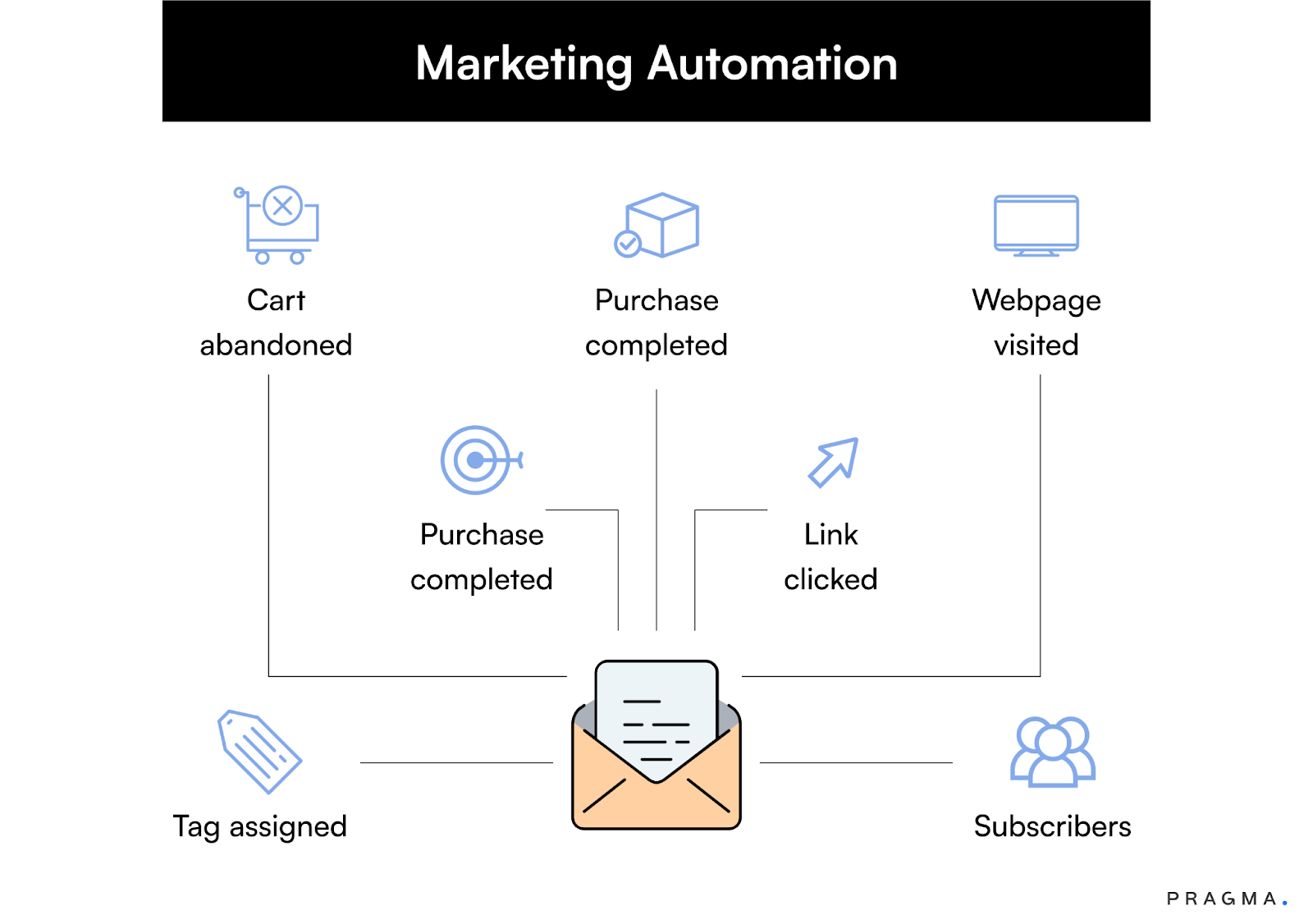
What Is Marketing Automation?
Marketing automation is the use of software and AI-driven tools to streamline repetitive marketing tasks—such as sending messages, nurturing leads, segmenting audiences, and tracking customer behaviour—without manual effort.
Instead of handling every follow-up, campaign, or customer interaction yourself, automation lets you build workflows that run on autopilot.
For e-commerce and D2C brands, marketing automation means delivering the right message to the right customer at the right time, based on their interests, past purchases, and behaviour. From abandoned cart recovery and WhatsApp drip campaigns to personalised product recommendations, automation helps brands save time, reduce manual workload, and dramatically increase conversions
About 75% of brands already use at least one kind of marketing automation tool, with 63% of marketers planning to increase their automation budgets.
The idea behind using automation in marketing is to create personalised customer journeys, track user behaviour across touchpoints, and respond to customer actions in real-time.
Ahead, in this guide, you’ll learn what the advantages of marketing automation you can experience by applying it in your brand’s overall marketing.
Top Benefits of Marketing Automation
Let me explain some of the immediate and long-term benefits you can enjoy by using automation.
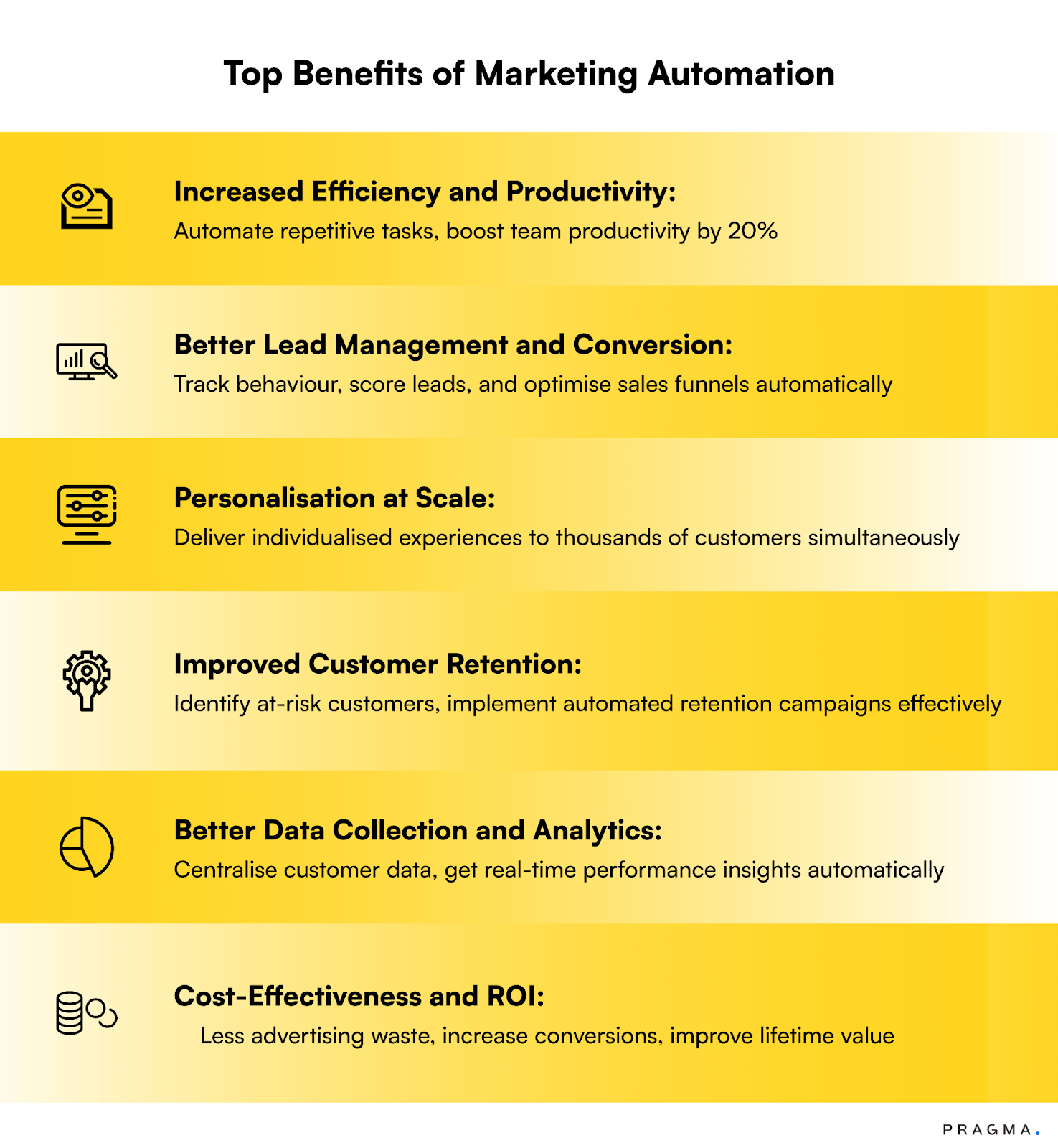
Increased Efficiency and Productivity
Manual marketing tasks that previously required hours of work can be completed automatically, freeing up your team members to focus on more important activities like A/B testing creatives, ad copy and more.
So your teams can schedule campaigns weeks or months in advance, set up complex trigger-based sequences, and manage multiple customer segments simultaneously.
Research shows that automation improves productivity by 20%, allowing your marketing teams to handle larger customer volumes without adding more staff.
Such efficiency gain allows brands that need to scale their operations without dramatically increasing overhead expenses.
Better Lead Management and Conversion
One of the important advantages of marketing automation tools is that they help you track customer behaviour across multiple touchpoints, score leads based on engagement levels, and automatically move prospects through optimised sales funnels.
These systems score leads automatically to identify high-potential customers based on their behaviour patterns, purchase history, and engagement levels.
Personalisation at Scale
Automation tools like CRM help you deliver highly personalised experiences to thousands of customers simultaneously, using data about past purchases, browsing behaviour, and demographic information to customise messaging.
Now, personalisation using CRM isn’t just about inserting a customer's name into email templates, it also lets you recommend products based on consumers previous purchases, adjust pricing based on customer segments, and even modify website content based on visitor behaviour.
For example, showing one-time coupon codes for first-time customers or a special price drop for repeat customers.
Improved Customer Retention
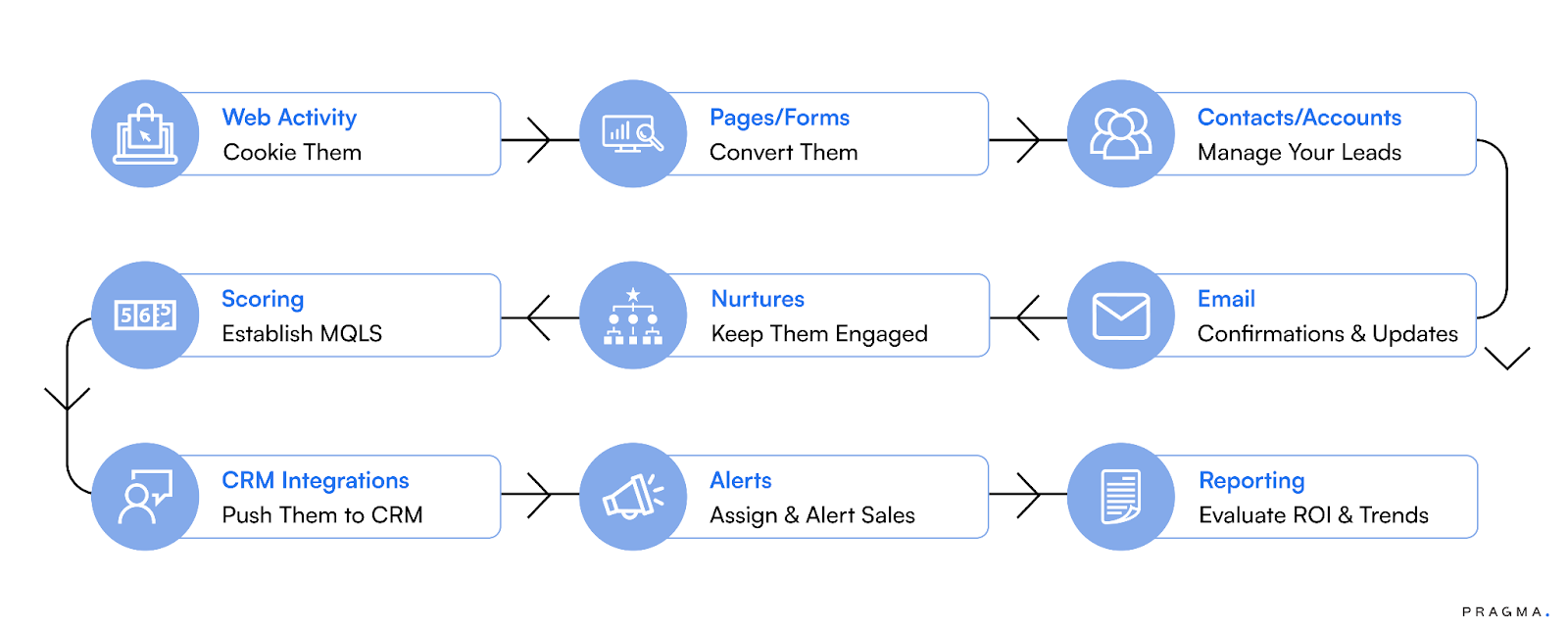
The advantages of marketing automation are that it excels at maintaining ongoing relationships with existing customers by automatically identifying customers at risk of churning and implementing targeted retention strategies.
Such automated retention campaigns often include post-purchase follow-ups, loyalty program management, reactivation sequences for dormant customers, and personalised upsells based on purchase history.
By connecting with customers over these touchpoints, you maintain brand awareness and encourage repeat purchases.
Better Data Collection and Analytics
Automation tools serve as an all-in-one data collection system, capturing information about customer behaviour, campaign performance, and sales across channels.
This eliminates the manual work of creating reports from multiple systems, so you get access to real-time dashboards showing campaign performance, customer engagement metrics, and revenue updates.
And the data collected through automation improves over time, as these tools learn from customer interactions to constantly give you insights to refine your marketing activities.
Cost-Effectiveness and ROI
By automating your marketing process, you save costs from multiple sources, such as improved campaign targeting that reduces wasted advertising spend, higher conversion rates that improve revenue per visitor, and better customer retention that increases lifetime value.
These combined benefits often result in automation paying for itself within the first year of implementation.
Considerations & Minor Drawbacks
While the advantages of marketing automation appeal especially to brands competing in cluttered segments, it still possesses a fair share of downsides, which mostly happen due to the following mistakes.
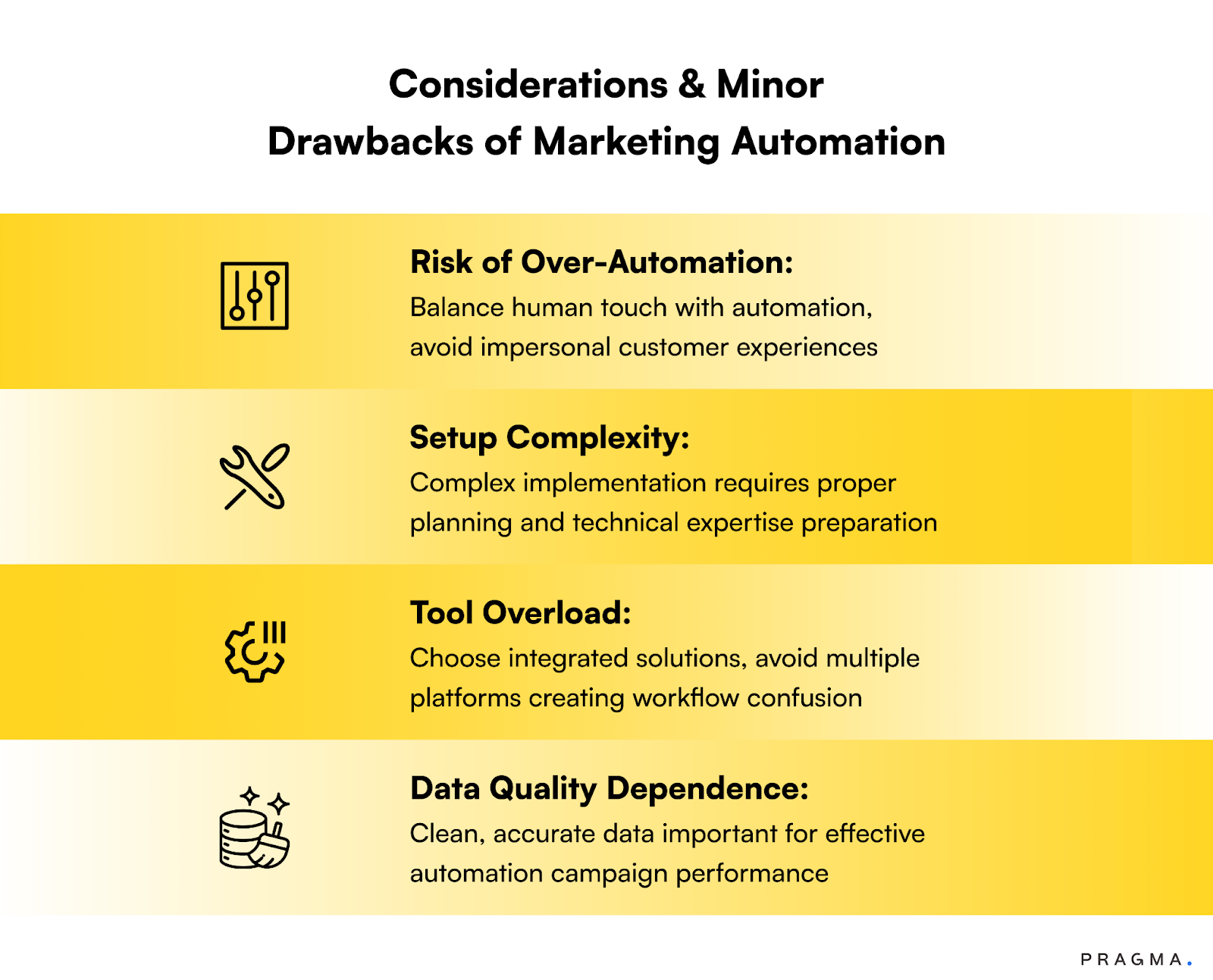
Risk of Over-Automation
One of the common mishaps is when you try to automate too many customer interactions, which often results in impersonal experiences that alienate customers instead of engaging them.
For example, customer service inquiries requiring empathy or complex campaign analysis.
To ensure automation works for you and not the other way around, maintain the human element in activities where required and automate routine tasks that don't require personal attention.
This will help customers feel valued and understood rather than treated as data points in an automated system.
Setup Complexity
The advantages and disadvantages of marketing automation tools are that these are complex setups that often overwhelm teams without proper preparation and expertise.
Because 16% of marketers consider creating quality automations their primary challenge.
Apart from basic implementation, such as mapping customer journeys, integrating multiple systems, configuring automation rules, and training team members on new platforms.
Other processes like customer segmentation, message sequencing, etc, can delay launch timelines and require more resources than initially anticipated.
Tool Overload
With 20% of agencies struggling to find the right marketing automation tool, choosing the right solution is no easy task and requires a detailed evaluation of your brand's needs.
Tool overload can occur when brands try to deploy multiple automations without proper integration, which creates data silos and workflow inefficiencies.
This fragmentation almost contradicts the advantages of marketing automation by creating confusion over making operations efficient.
So be sure to choose a tool that integrates well with your existing systems and gives you complete functionality.
Data Quality Dependence
Data quality issues include incomplete customer profiles, outdated contact information, duplicate records, and inconsistent data formatting across systems.
These problems can result in irrelevant messaging, failed delivery attempts, and poor campaign performance that undermines automation benefits.
How to Implement Marketing Automation in Your Business
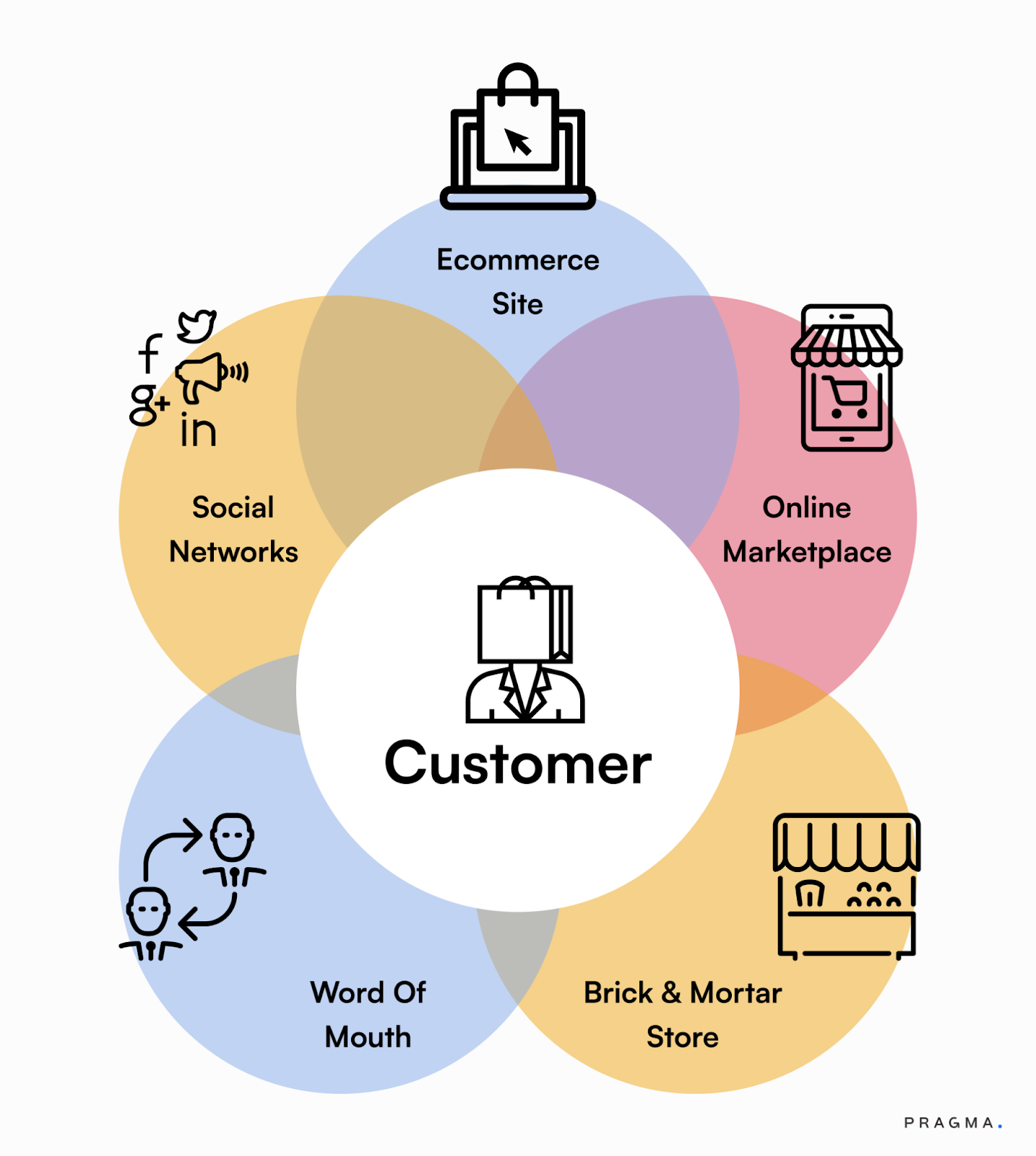
To ensure your automation tool does its job, which is to make life easy for your marketing team, be sure to implement it in the right manner as mentioned below.
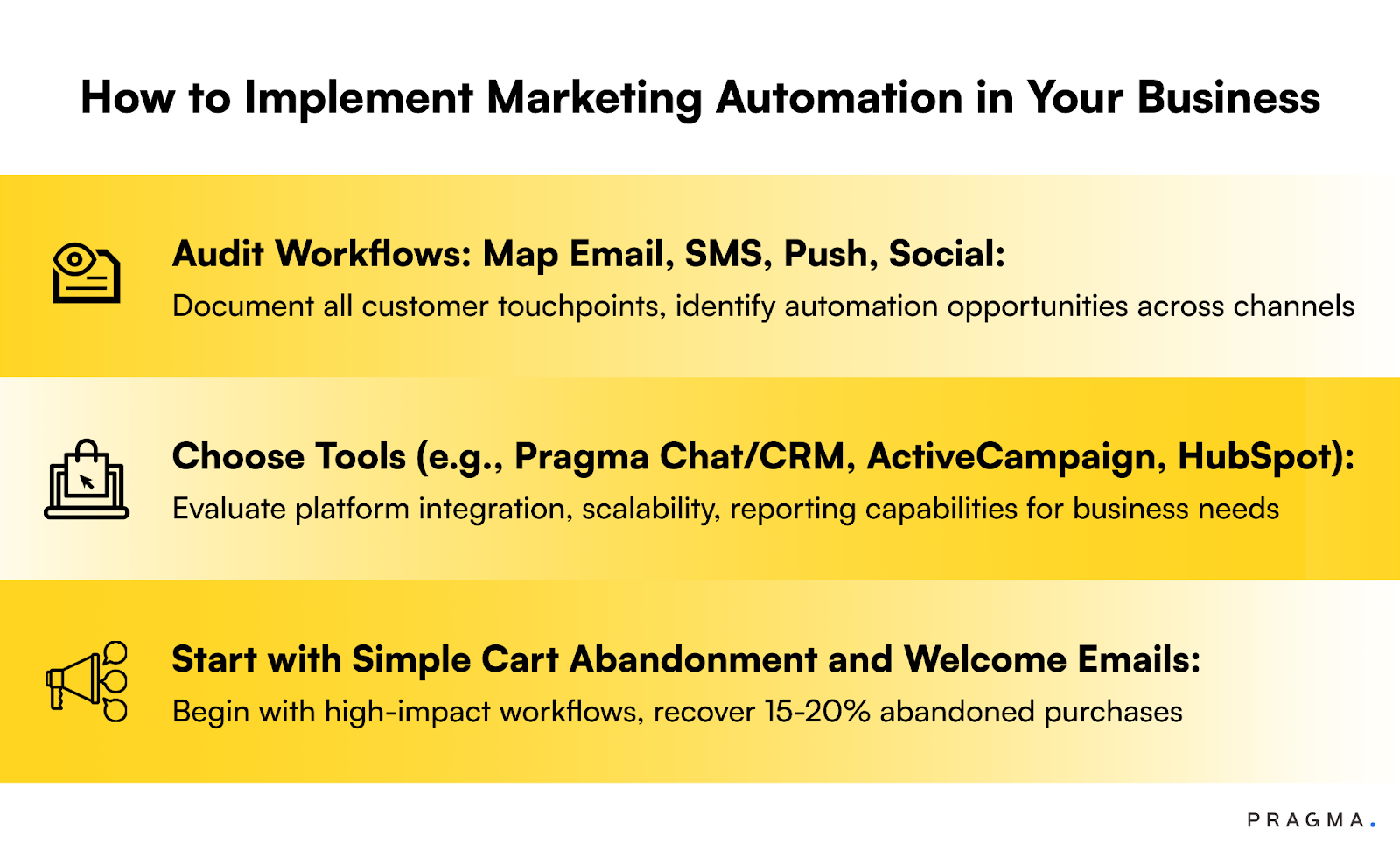
Audit Workflows: Map Email, SMS, Push, Social
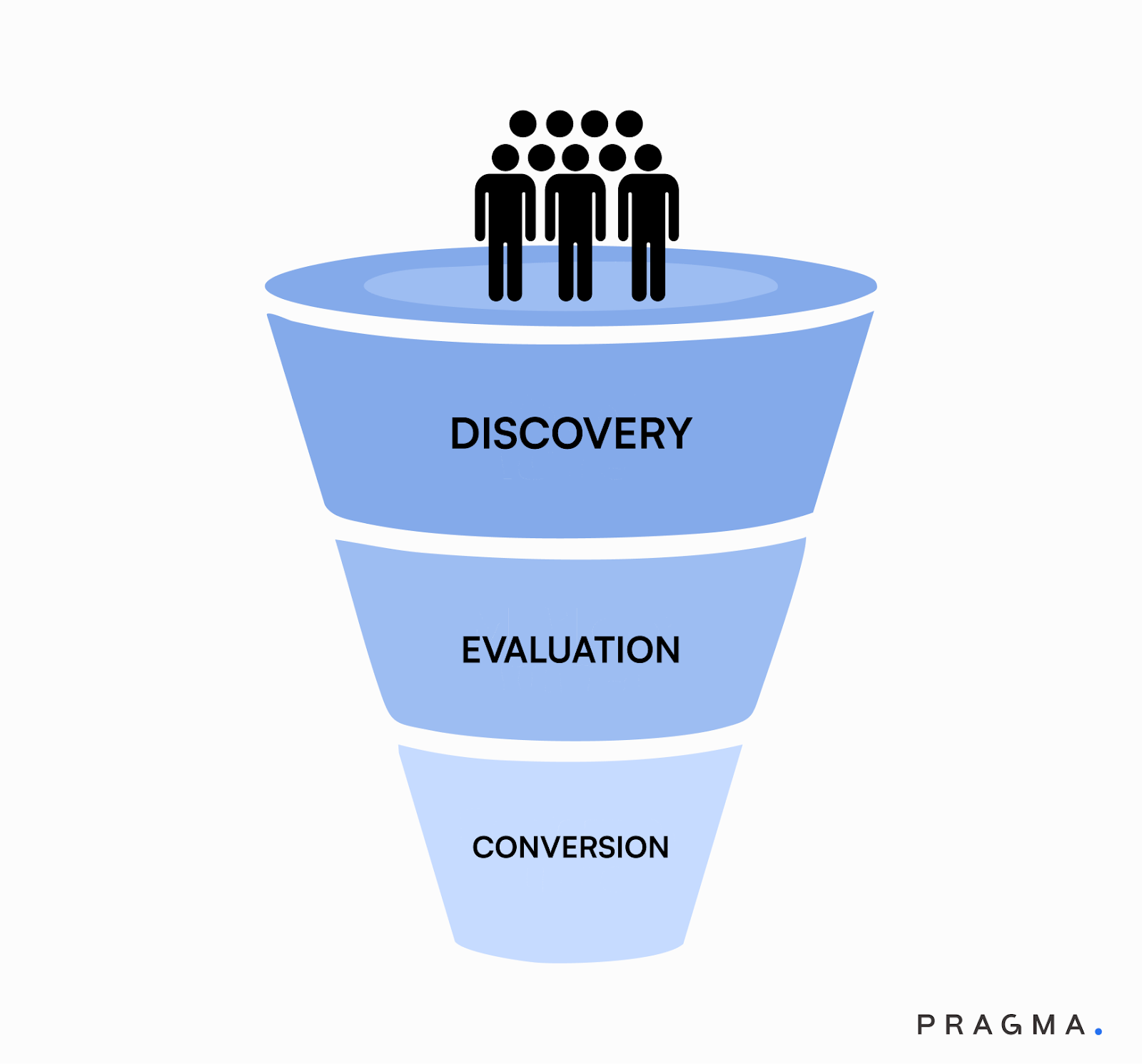
Start by documenting every customer interaction from initial awareness through post-purchase follow-up.
Be sure to map all customer touchpoints across email, SMS, push notifications, and social media channels to create a complete picture of existing communication strategies.
This mapping exercise will help you identify gaps where automation can improve consistency and effectiveness.
Pay particular attention to manual tasks that consume the most time or require repetitive actions across multiple marketing processes.
Email workflows are the most common area of automation, including welcome sequences, cart abandonment campaigns, post-purchase follow-ups, and re-engagement series for inactive subscribers.
SMS automation complements email campaigns with time-sensitive offers and delivery notifications, and push notifications also provide immediate engagement opportunities for mobile app customers.
For social media, focus on automating content scheduling and basic engagement monitoring.
The goal is to maintain consistent posting schedules and be alert for authentic engagement opportunities that require human attention.
Choose Tools (e.g., Pragma CRM/Chat, ActiveCampaign, HubSpot)
When evaluating platforms, consider integration capabilities with existing systems, ease of use for team members, scalability to support business growth, and pricing structures that align with budget constraints.
ActiveCampaign is best for email marketing automation with advanced segmentation capabilities and visual automation builders. HubSpot provides proper marketing, sales, and service automation within a unified platform. Pragma Chat focuses on WhatsApp marketing and customer relationship management for DTC brands.
Evaluate each platform's reporting capabilities, as data analysis is essential for optimising automated campaigns. Look for platforms that provide detailed performance metrics, attribution tracking, and integration with analytics tools like Google Analytics.
Start with Simple Cart Abandonment and Welcome Emails
Focus on high-impact, low-complexity workflows that deliver immediate results, such as cart abandonment and welcome email sequences, because they address common e-commerce challenges with straightforward automation logic.
Cart abandonment campaigns help recover 15-20% of abandoned purchases through timely, personalised reminders.
These campaigns start with simple email reminders sent within hours of abandonment, followed by additional touches that might include discount offers or alternative product suggestions.
Welcome email sequences help make immediate engagement with new subscribers or customers, with whom you can share brand values, set expectations, and guide recipients toward their first purchase.
These sequences typically include multiple emails spaced over several days or weeks, each designed to build a relationship and trust with new customers.
Start with basic versions of these campaigns using simple triggers and straightforward messaging.
As you get comfortable with the tool and see positive results, gradually add complexity through advanced segmentation, dynamic content, and additional workflow branches.
Recommended Tools for Indian E-commerce
Pragma

Pragma is an all-in-one DTC operating system that helps you automate omnichannel marketing through WhatsApp, Facebook, Instagram, Email and SMS.
It gives you complete control over getting orders from multiple sales channels and communicating with customers without asking them to move to your website.
From getting the maximum value from each customer through behaviour-based upsells and recommendations to personalised chatbots that take care of over 95% of incoming customer inquiries.
Pragma takes care of your entire purchase cycle, including the pre-purchase, post-purchase and post-delivery stages.
Key features:
- Omnichannel CRM to reach out to customers on channels where they spend most time, so you get more conversions.
- A branded checkout system that speeds up the checkout time to 10 seconds by giving customers multiple payment methods, including BNPL, UPI, cards, etc.
- WhatsApp ordering, for customers to browse, order, complete the payment and receive post-purchase support on a single medium.
- Order confirmation workflow to stop impulse shoppers, fraudulent orders and potential returns.
- RTO prevention system to turn customers orders from COD to prepaid ones, so you don't have to pay for the shipping costs
ActiveCampaign
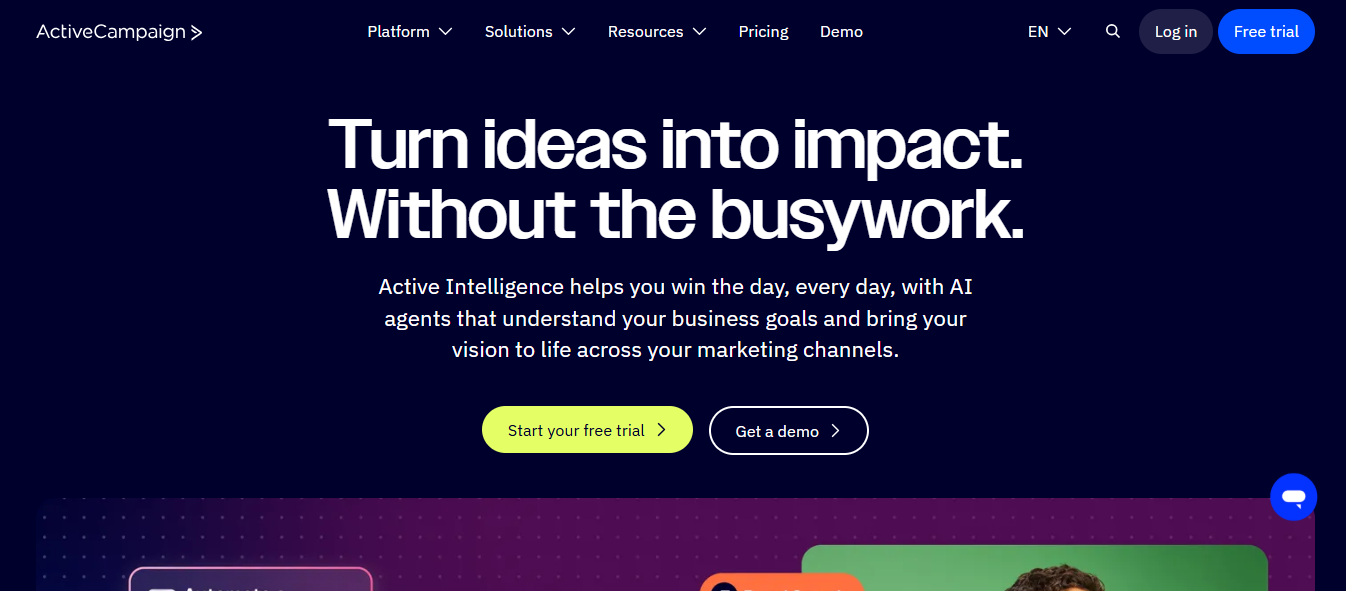
ActiveCampaign is a dedicated email marketing tool that helps you create personalised customer journeys using advanced automation workflows and templates.
The platform comes with cross-channel marketing automation through email, SMS, and social messaging, so you can reach customers across channels
Key features:
- Visual automation builder with 750-plus pre-built automation templates categorised by industry, which you can use without starting from scratch.
- AI-powered content creation that helps you generate personalised email copy, subject lines, and automation workflows.
- Advanced segmentation that automatically organises your shoppers based on engagement levels and behaviour, helping you focus on high-potential customers.
HubSpot
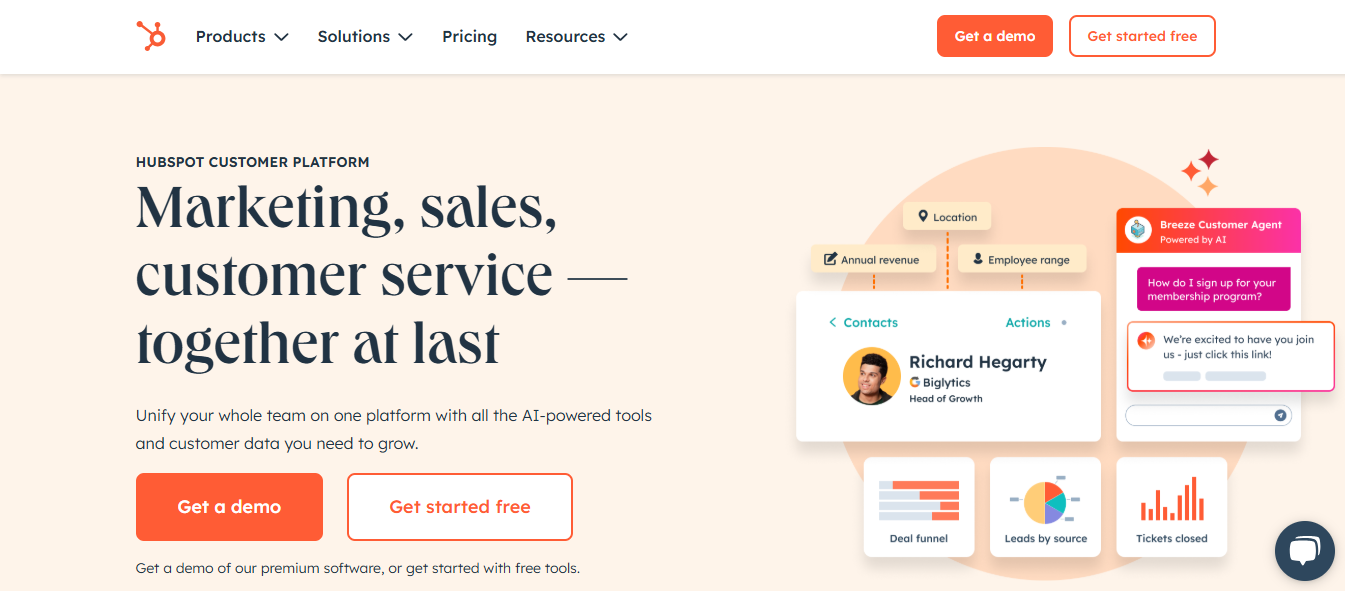
HubSpot Marketing Hub combines email marketing, CRM, social media management, and analytics in a single system to help you attract, convert, and retain customers.
The platform uses AI to analyse your customer behaviour patterns and automatically optimise campaign performance, resulting in marketing teams experiencing 8x more deals through improved reporting.
Key features:
- Visual workflow builder helps you create automated customer journeys based on consumer’s website visits, message replies, and email interactions.
- AI-driven email optimisation that gives you the best send times and subject lines based on your shopper’s past engagement patterns.
- Integrated CRM that automatically categorises customers based on where they stand in the buyer's journey, making it easier for your marketing team to create relevant messaging.
Zapier

Zapier is one of the most well-known automation tools that offers premade themes for almost all e-commerce operations, like inventory management, marketing automation, etc.
It helps you automate important sales KPIs tracking in your native spreadsheet or BI tools, without any need for manual data entry.
Key features:
- Sync product updates automatically between your store and accounting system to maintain real-time inventory and financial records.
- Tag every new customer in the right marketing segment for future personalised messaging.
- Speed up order fulfilment by processing each new purchase through shipping, inventory, marketing and CRM instantly.
To Wrap It Up
As your competitor brand gets closer to your target customers, your way to reach them first and start the engagement first is through automation.
Because when you automate your marketing, you provide customers with a memorable experience, which is important to build engagement ahead.
And to do that, I’ve explained the steps you can follow to enjoy the advantages of marketing automation.

FAQs (Frequently Asked Questions On Advantages of Marketing Automation for E-commerce)
How does e-CRM help in marketing automation?
E-CRM stores customer data that triggers personalised email campaigns and automated follow-up sequences.
Is marketing automation part of CRM?
Marketing automation works with CRM systems to nurture leads and track customer interactions throughout sales.
How to use AI in marketing automation?
AI analyses customer behaviour patterns to send personalised messages at optimal times for higher conversions.
What is marketing automation in e-commerce?
Marketing automation uses software to streamline and automate repetitive marketing tasks, making campaigns faster, more efficient, and personalized.
What are the main benefits of marketing automation for e-commerce brands?
Benefits include increased productivity, better lead management, personalized messaging at scale, improved customer retention, robust data analytics, and higher ROI.
How does marketing automation help boost productivity?
It allows teams to schedule, trigger, and manage campaigns and customer segments automatically, freeing up time for strategy and creative work.
Can marketing automation improve customer retention?
Yes, by automating post-purchase follow-ups, loyalty campaigns, and tailored upsell offers, brands keep customers engaged and drive repeat purchases.
How does automation enable personalized marketing?
Automation uses customer data to customize messages, product recommendations, offers, and content based on individual preferences and behaviors.
Are there risks or drawbacks to marketing automation?
Over-automation can lead to impersonal experiences, and setup complexity or tool overload can create workflow inefficiencies if not managed carefully.
Talk to our experts for a customised solution that can maximise your sales funnel
Book a demo

.webp)


.png)